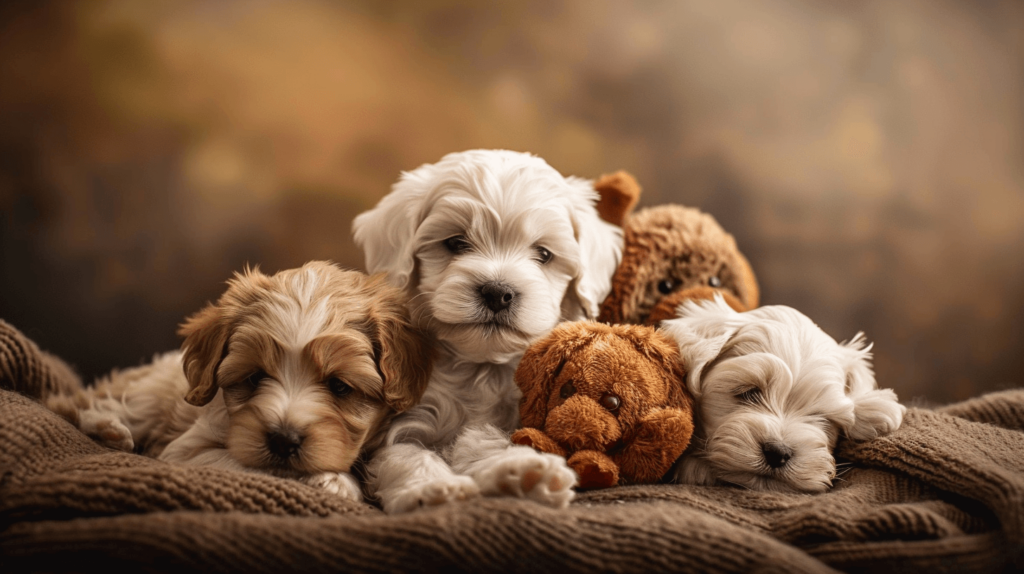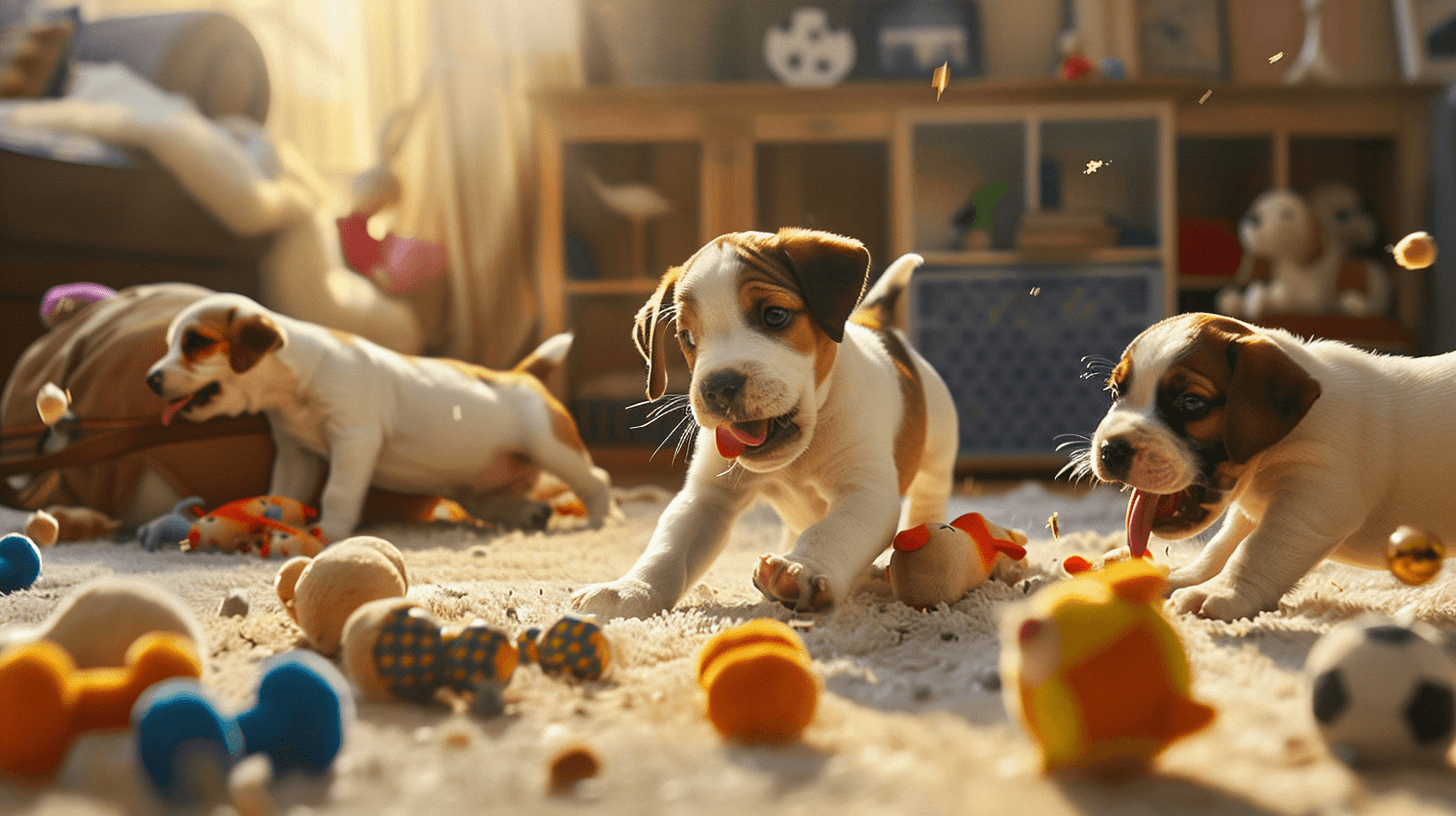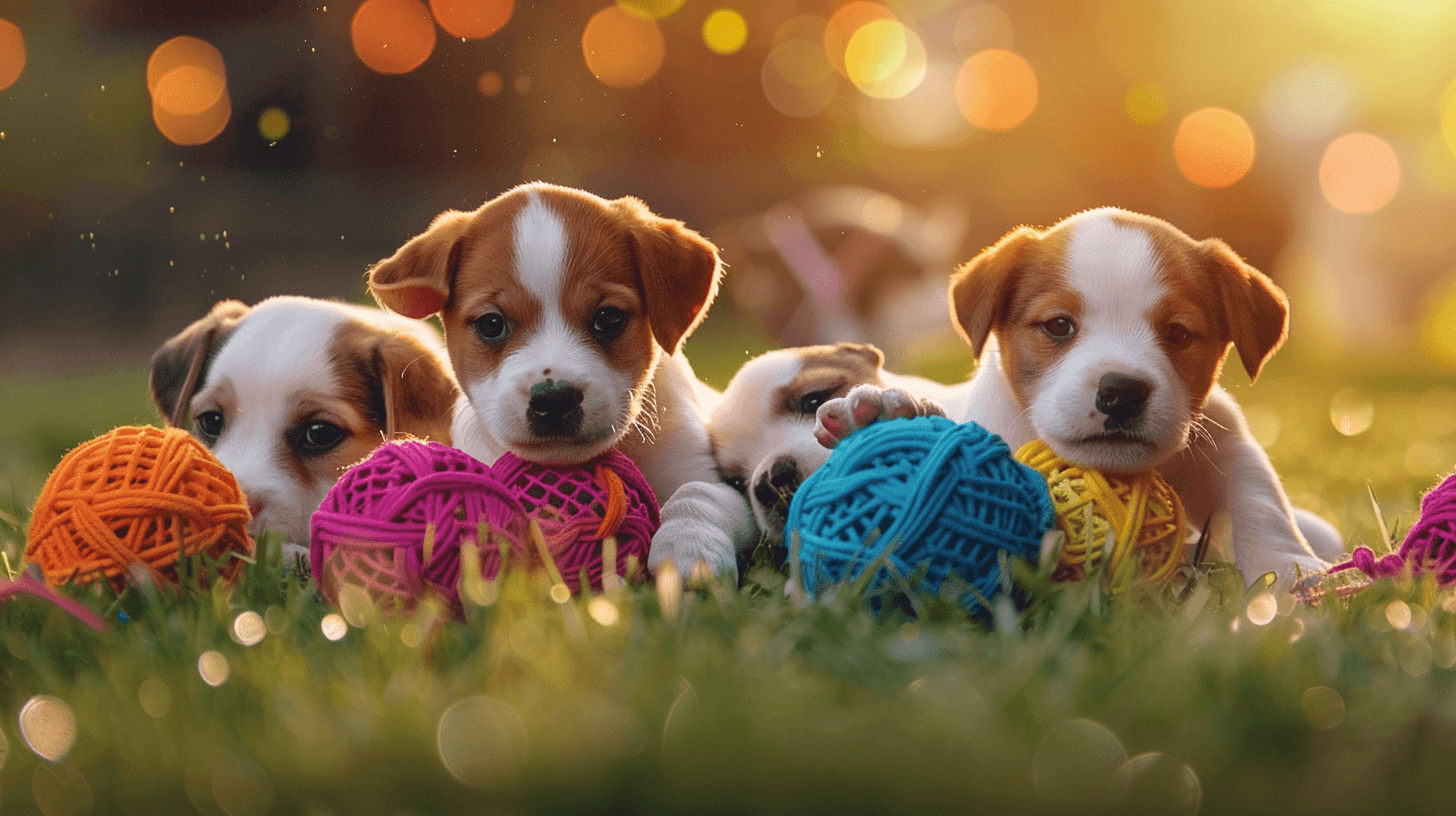Bringing a new puppy into your home is a journey filled with laughter, love, and a fair share of learning curves. As a devoted dog enthusiast who’s navigated the joys and challenges of puppyhood more times than I can count, I’ve come to understand that the toys we choose for our furry friends do much more than keep them busy.
They’re vital tools that support our puppies’ growth, teach them about the world, and even keep them safe from harm. That’s why choosing toys for puppies is a task that goes beyond the simple act of picking the most colorful or squeakiest option off the shelf; it’s about making informed decisions that enhance our puppies’ lives in meaningful ways.
The significance of play in a puppy’s development cannot be overstated. It’s through play that our pups learn boundaries, develop physical coordination, and start to understand their place within our world. But not all toys are created equal.
The best puppy developmental toys strike a delicate balance between stimulating fun and ensuring safety, guiding our puppies through their growth stages while protecting them from potential dangers. From safe puppy toys that soothe teething gums to interactive dog toys that challenge their minds, every choice we make has the potential to contribute to their well-being.
In this exploration of choosing the right toys for puppies, we’ll delve into the developmental benefits of carefully selected playthings, outline the criteria for puppy toy safety, and share some of the best dog toys reviewed for their enriching qualities.
Whether you’re navigating puppy playtime for the first time or looking to refresh your beloved companion’s toy box with engaging toys for puppies, this guide is designed to arm you with the knowledge needed to make the best choices for your growing friend.
Join me as we embark on this journey, ensuring our puppies not only have fun but also thrive in their formative months. Let’s create a foundation of joyous and safe exploration for our puppies, one carefully chosen toy at a time.
Contents
- 1 The Importance of Play in Puppy Development
- 2 Understanding Puppy Play Needs
- 3 Criteria for Choosing Safe Puppy Toys
- 4 Recommended Types of Safe and Developmental Toys for Puppies
- 5 Balancing Fun and Safety During Puppy Playtime
- 6 Conclusion: Enriching Your Puppy’s Journey with the Right Toys
- 7 Recommended Resources for Puppy Toys
The Importance of Play in Puppy Development
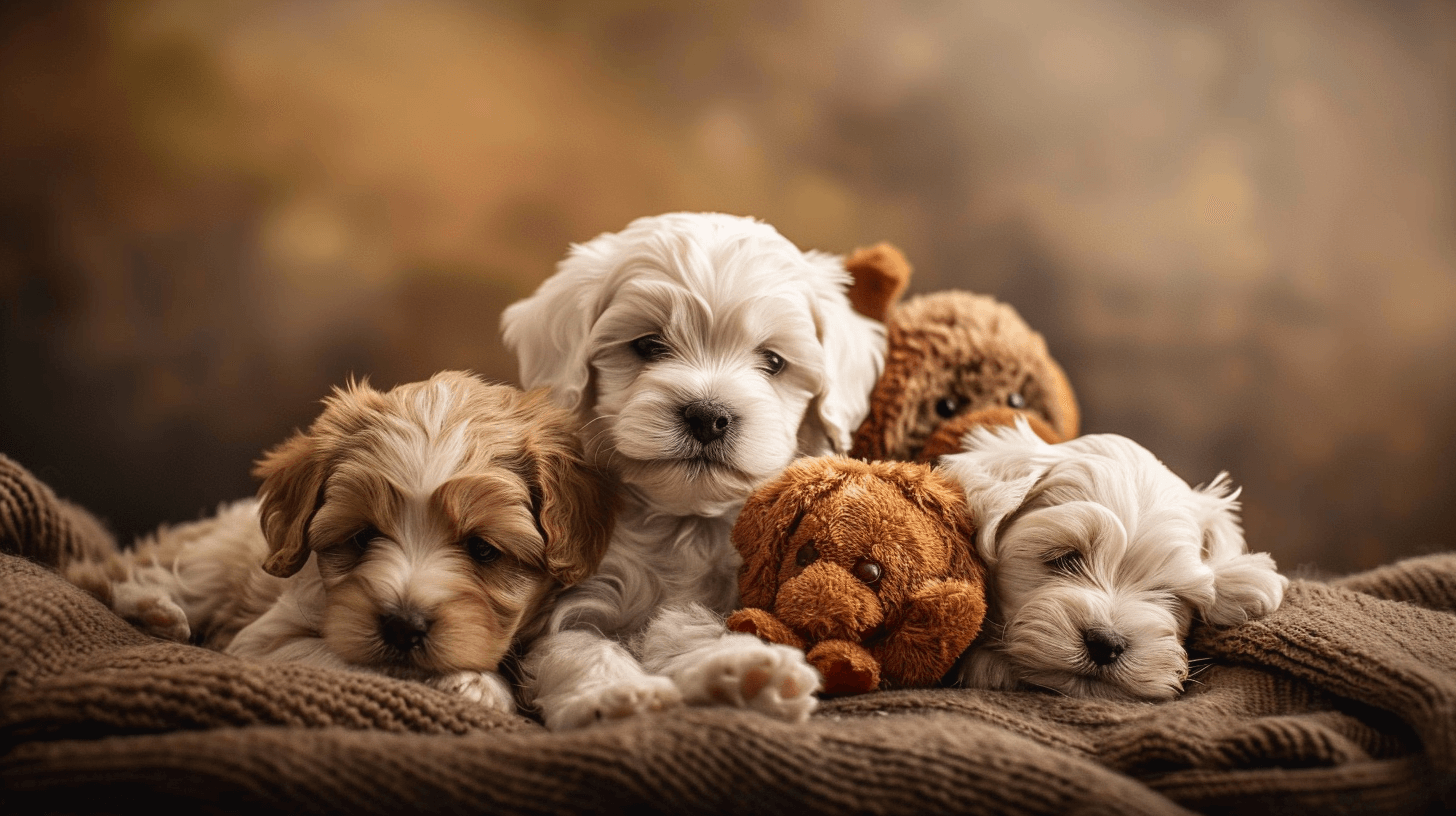
The sound of a puppy at play is not just a source of joy for pet owners; it’s a vital part of their journey to becoming well-adjusted, healthy dogs. As someone who’s shared countless hours of play with pups of all shapes and sizes, I’ve witnessed firsthand the transformative power of play.
It’s through these playful interactions that puppies learn about the world around them, develop crucial social skills, and build the physical and mental foundations they’ll rely on for the rest of their lives.
Learning Through Play
Play is not just fun for puppies; it’s their primary mode of learning. Every chase of a ball, every tug-of-war with a rope toy, and every puzzle toy solved is an opportunity for learning. These activities help puppies develop coordination, increase their problem-solving skills, and understand their own strength and abilities.
Moreover, playtime is a critical component of their social development, teaching them cues about interaction, bite inhibition, and the establishment of hierarchies and boundaries.
Physical and Mental Health
The benefits of play extend well beyond the immediate joy it brings. Regular, active play sessions contribute significantly to a puppy’s physical health, aiding in the development of strong bones and muscles. Equally important is the impact on mental health; play keeps puppies engaged, wards off boredom, and helps prevent the development of anxiety and other behavioral issues.
Interactive toys for dogs, in particular, can stimulate their minds, encouraging them to think creatively and solve problems.
Bonding and Trust
Playtime is an invaluable opportunity for bonding between puppies and their owners. It establishes trust, builds a mutual language of cues and responses, and strengthens the emotional connection. Engaging toys for puppies can facilitate this bonding process, offering shared activities that are both enjoyable and enriching.
Through play, puppies learn to see their human companions as sources of fun and safety, laying the groundwork for a lifelong friendship.
Choosing the Right Toys
In understanding the importance of play, it becomes clear that choosing the right toys for puppies is a decision with far-reaching implications. The best dog toys are those that cater to a puppy’s developmental stage, size, and individual preferences. They should offer a mix of physical exercise, mental stimulation, and opportunities for social interaction.
From chew toys that relieve teething discomfort to puzzle toys that challenge their intellect and fetching toys that improve their agility and coordination, each toy serves a purpose in a puppy’s developmental journey.
Key Takeaways
- Play is Essential: It’s through play that puppies learn, grow, and develop into healthy, well-adjusted dogs.
- Developmental Benefits: Playtime offers immense benefits for a puppy’s physical coordination, mental acuity, and social skills.
- The Right Toys Matter: Selecting toys that align with a puppy’s developmental needs can significantly enhance the benefits of play, making every game an opportunity for growth.
As we move forward, we’ll dig deeper into the types of play and how they contribute to a puppy’s growth, guiding you in choosing puppy toys that are not just safe, but also profoundly beneficial for your furry friend’s development.
Understanding Puppy Play Needs
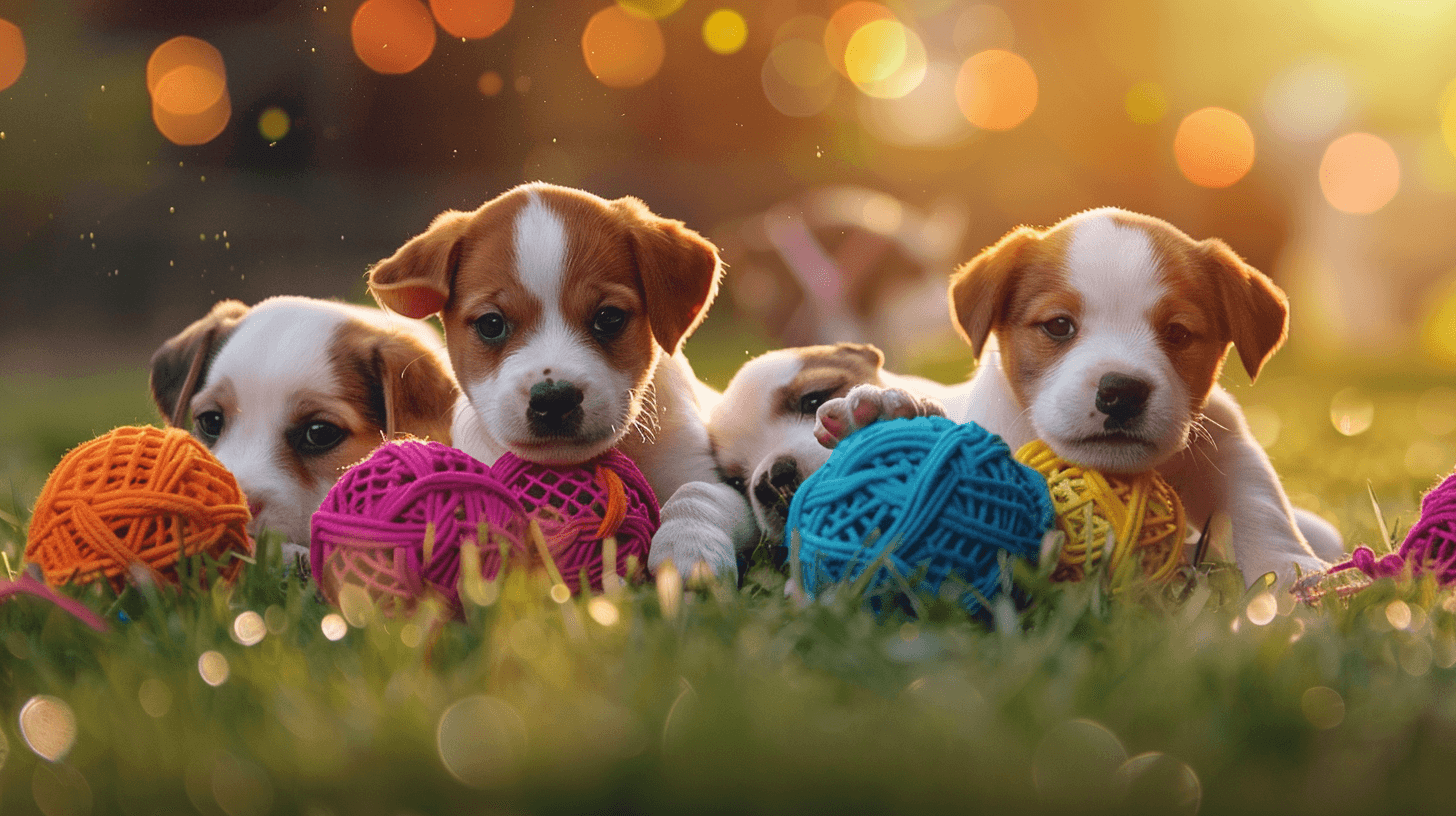
When it comes to puppies, play is as natural and necessary as eating or sleeping. Each playful moment is laced with opportunities for development and discovery. As a seasoned guide in the world of dog care, I’ve observed the spectrum of play needs across different puppies and how these needs evolve as they grow.
Let’s unpack the essence of puppy playtime, emphasizing the critical role of developmental toys for dogs and how they cater to various aspects of growth.
Types of Play and Their Benefits
- Chewing: Puppies go through teething phases, making chew toys not just a preference but a necessity. Safe puppy toys designed for chewing can provide relief from teething pain, help in the development of strong jaws, and ensure that your puppy is chewing on something safe and designed for this purpose rather than household items.
- Fetching: Games that involve fetching are fantastic for physical exercise, coordination, and learning commands. These activities also foster a sense of cooperation and responsiveness to cues, crucial for obedience training.
- Tug-of-War: A controlled game of tug-of-war can teach puppies about bite inhibition and strength control. It’s also an excellent way for them to engage in play that simulates the natural push and pull found in social interactions among dogs.
- Puzzle Solving: Interactive toys for dogs that require them to solve puzzles for rewards offer mental stimulation, reduce boredom, and develop problem-solving skills. These toys can vary in complexity to remain challenging as your puppy grows.
Interactive Toys for Enhanced Engagement
Interactive dog toys, including those that dispense treats or require manipulation to achieve a goal, are invaluable for mental stimulation. They keep a puppy’s mind active, reduce instances of destructive behavior by providing an outlet for their energy, and enhance their learning and problem-solving abilities. Engaging toys for puppies can include everything from simple treat balls to more sophisticated puzzle toys.
Safety and Suitability
While the variety of play is beneficial, safety remains paramount. Not all toys are suitable for every puppy, and what works for a large breed may not be safe for a small one. The size of the toy should be appropriate to prevent choking hazards, and the material should be durable enough to withstand vigorous play without breaking apart and becoming ingested.
Choosing Puppy Toys Wisely
Understanding your puppy’s play needs is the first step in choosing toys that will be both enjoyed and beneficial. Observing how your puppy plays and what types of activities they’re drawn to can guide your selection of toys, ensuring you provide a balanced array of options that cater to chewing, fetching, tugging, and solving activities.
Always consider the developmental stage of your puppy and choose toys that support their growth without posing any risks.
Key Takeaways
- Diverse Play Needs: Puppies benefit from a variety of play types, each supporting different aspects of their development.
- Interactive and Engaging: Choosing interactive and engaging toys can significantly enhance a puppy’s mental stimulation and learning.
- Safety First: Always prioritize safety by selecting toys that are appropriate for your puppy’s size and chewing strength.
As we venture further into the world of puppy toys, the focus on safety and developmental benefits becomes increasingly important. The next section will detail how to choose safe puppy toys, ensuring that playtime is always a source of joy and growth.
Criteria for Choosing Safe Puppy Toys
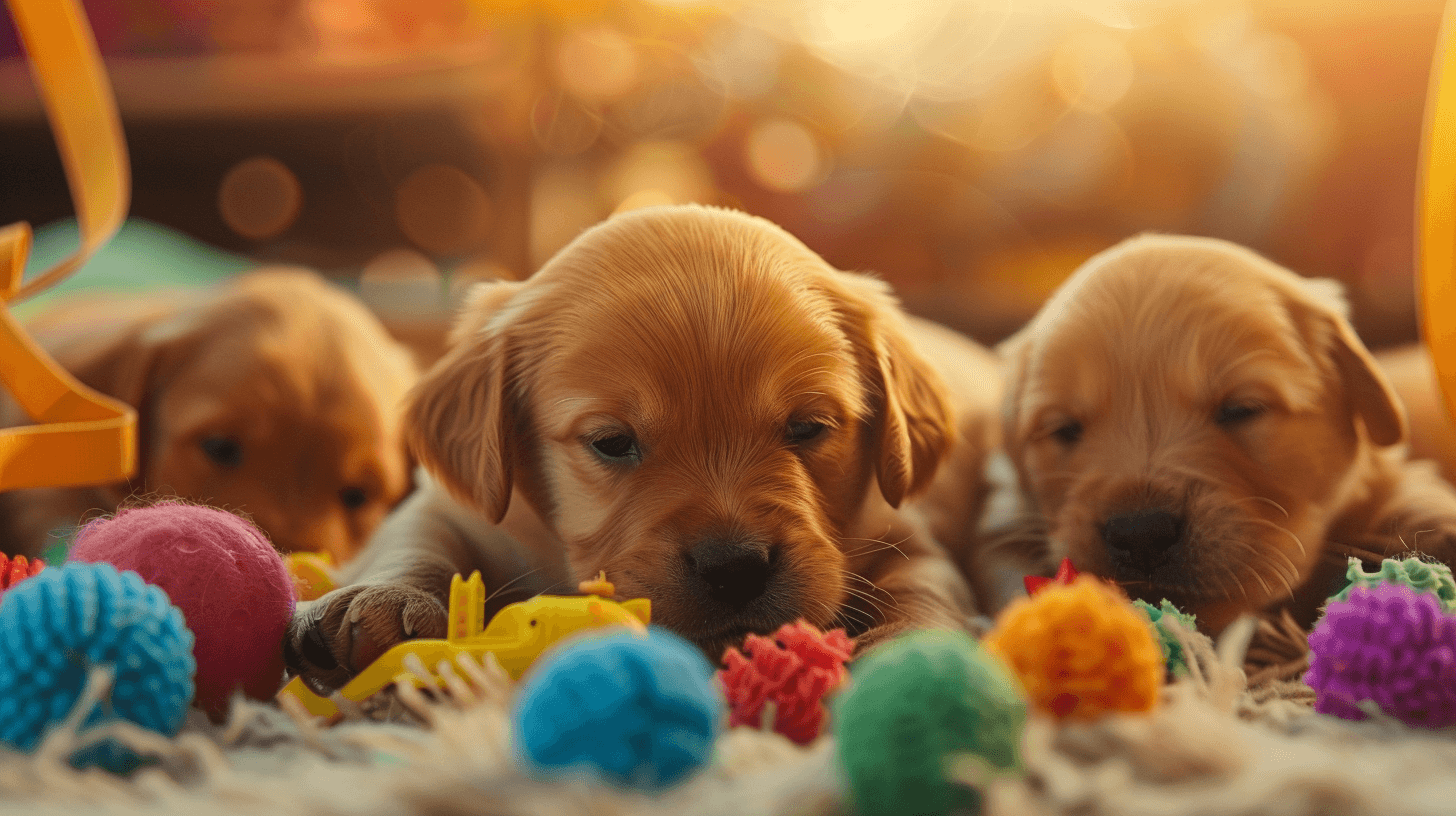
Ensuring the toys we provide our puppies are safe is as crucial as ensuring the food they consume is nutritious. In my years of canine companionship, I’ve learned that a toy’s safety isn’t just about its immediate risk but also its contribution to a puppy’s long-term well-being.
Here are essential criteria to consider when selecting safe puppy toys, ensuring that playtime is both fun and secure.
Size and Shape
The size of the toy is paramount in preventing choking hazards. A safe puppy toy should be large enough that it cannot be swallowed or lodged in the puppy’s throat, but not so large that it’s unwieldy for them to play with. Additionally, the shape of the toy should not have sharp edges or points that can cause injury during play.
Material Quality
Toys made from non-toxic, durable materials are a must. Look for toys manufactured specifically for puppies, as they are more likely to be free from harmful chemicals and designed to withstand sharp puppy teeth. Avoid toys made from hard plastic or brittle materials that can break into sharp pieces, posing ingestion or injury risks.
Chew Resistance
Puppies explore the world with their mouths, making chew resistance a critical factor in toy safety. While no toy is indestructible, choosing ones that are made for heavy chewing can minimize the risk of your puppy tearing off pieces and ingesting them. Regularly inspect chew toys for signs of wear and replace them when necessary.
Noise and Stimulation
While not a direct safety concern, it’s important to consider the level of noise a toy makes and how it might affect your puppy. Some toys may produce sounds that are too loud or startling for young pups, leading to fear or anxiety. Similarly, toys that are overly stimulating may overexcite puppies, leading to erratic behavior or exhaustion.
Washability
Hygiene plays a role in safety, too. Toys that can be easily cleaned will help prevent the buildup of bacteria that could harm your puppy’s health. Opt for toys that can be washed in the dishwasher or easily rinsed under hot water.
Engaging Toys for Puppies
Beyond safety, toys should offer developmental benefits, such as those that encourage problem-solving, improve motor skills, or enhance sensory development. Engaging toys for puppies often include features like varying textures, sounds, or hidden compartments for treats that stimulate their curiosity and cognitive development.
Key Takeaways
- Appropriate Size and Shape: Ensure toys are a suitable size to prevent choking and do not have harmful edges.
- Non-toxic Materials: Select toys made from durable, non-toxic materials designed for puppies.
- Chew Resistance: Choose toys that can withstand your puppy’s chewing, regularly inspecting them for damage.
- Consider Noise and Stimulation: Avoid toys that might overstimulate or frighten your puppy.
- Cleanability: Opt for toys that are easy to clean, maintaining a hygienic play environment.
Safety in puppy toys is a blend of right selection, regular inspection, and understanding your puppy’s play habits. As we move forward, we’ll delve into specific recommendations for safe and developmental toys that can enrich your puppy’s playtime, ensuring their growth and happiness go hand in hand.
Recommended Types of Safe and Developmental Toys for Puppies

Through years of experience and countless hours spent in the company of puppies, I’ve come to identify certain types of toys that consistently stand out for their safety, durability, and developmental benefits. Here, I’ll share a curated selection of toys that have proven to be both enjoyable for puppies and reassuring for their human companions.
Chew Toys for Dental Health and Comfort
- Rubber Chew Toys: Durable and flexible, rubber chew toys can withstand vigorous chewing and help soothe the discomfort of teething. Look for products from reputable brands known for their pet-safe materials.
- Dental Chew Toys: Designed with ridges or nubs to help clean teeth and freshen breath as your puppy chews, these toys promote oral health while satisfying the natural urge to chew.
Interactive Toys for Mental Stimulation
- Puzzle Feeders: These toys dispense treats or kibble as your puppy solves the puzzle, encouraging problem-solving skills and slowing down fast eaters.
- Treat Balls: Simple yet effective, treat balls release food as they’re rolled, providing both physical exercise and mental stimulation.
Fetch Toys for Physical Activity and Training
- Soft Frisbees: Made from flexible, durable materials, soft frisbees are gentle on a puppy’s mouth and great for interactive play in open spaces.
- Rope Toys: Good for tug-of-war and fetch, rope toys can help with teething and are excellent for interactive play, strengthening the bond between you and your puppy.
Plush Toys for Comfort and Socialization
- Soft Plush Toys: Plush toys can offer comfort to puppies, especially those new to their home. Choose toys with stitched eyes and noses to avoid choking hazards.
- Squeaky Toys: The squeaking sound can stimulate a puppy’s interest and curiosity, but ensure these toys are durable and check them regularly for signs of wear.
Safety and Selection Tips
- Inspect Regularly: No matter how durable a toy seems, regular inspection for signs of wear and tear is essential. Remove any damaged toys to prevent your puppy from ingesting small parts.
- Variety is Key: Offering a variety of toys will not only keep your puppy entertained but also cater to the different aspects of their development, from teething to cognitive growth.
- Supervised Play: Especially with new toys or toys that have moving parts and squeakers, supervised play can prevent accidents and help you gauge how well a toy holds up to your puppy’s play style.
Key Takeaways
- Chew Toys: Essential for teething puppies, promoting dental health, and satisfying the urge to chew.
- Interactive Toys: Enhance mental stimulation and problem-solving abilities.
- Fetch and Tug Toys: Support physical health, training, and strengthen the bond between pet and owner.
- Plush and Comfort Toys: Offer emotional support and aid in socialization.
Choosing the right toys for your puppy involves considering their individual needs, preferences, and safety. By providing a mix of engaging, developmental, and safe toys, you’re not just enriching their playtime; you’re contributing to their overall growth and well-being. In the next section, we’ll explore how to balance fun and safety, ensuring that every play session is both enjoyable and secure.
Balancing Fun and Safety During Puppy Playtime

Navigating the exciting world of puppy playtime involves more than just providing a collection of toys; it’s about creating a safe, stimulating environment where your puppy can explore, learn, and grow.
Drawing from my adventures and misadventures in raising spirited puppies, I’ve learned that the key to a successful playtime lies in striking a balance between fun and safety. Here’s how you can achieve that balance, ensuring your puppy benefits fully from their play while minimizing risks.
Supervise Interactive Play
Active supervision during playtime is crucial, especially with new toys or when introducing your puppy to complex play mechanisms. Watching how your puppy interacts with different toys allows you to intervene if they begin to chew pieces off or if the toy seems to be causing frustration rather than joy.
Supervision also offers the perfect opportunity for bonding and teaching your puppy how to play safely and appropriately.
Rotate Toys to Maintain Interest
Puppies, much like human children, can grow bored with the same toys. Rotating their toys not only keeps their interest piqued but also extends the life of the toys and keeps your puppy engaged in a variety of developmental activities. Introduce one or two new toys while temporarily retiring others, creating a cycle that continually stimulates your puppy’s curiosity and learning.
Create a Safe Play Environment
Ensure the play area is free from hazards that could harm your puppy during playtime. Remove small objects they could swallow, secure cords and drapes out of reach, and provide a comfortable, enclosed space where they can play without the risk of injury. The environment should encourage exploration but within the bounds of safety.
Teach Appropriate Play Behaviors
Use playtime as an opportunity to teach your puppy about gentle play and to recognize their own limits. Encourage games that foster positive interactions, such as fetch or tug-of-war with rules (like releasing the toy on command), to build discipline and control. Redirect aggressive or overly rough play to more suitable activities, reinforcing good behaviors with praise and treats.
Know When to End Playtime
Recognizing signs of fatigue or overstimulation in your puppy is essential. Puppies have a lot of energy, but they also need plenty of rest. Overly long play sessions can lead to exhaustion or irritability. Look for cues like disinterest in toys, yawning, or lying down, indicating it’s time for a break.
Key Takeaways
- Supervise Play: Active supervision ensures safety and facilitates bonding.
- Rotate Toys: Keeps playtime interesting and developmentally stimulating.
- Safe Environment: A hazard-free play area allows puppies to explore and play without risks.
- Teach Good Play Habits: Promotes discipline and positive behaviors during play.
- Monitor for Overstimulation: Ensures playtime ends before exhaustion or irritation sets in.
By balancing the joy and excitement of play with a mindful approach to safety and learning, you create a nurturing environment for your puppy’s development. Playtime becomes not just a fun break in the day but a cornerstone of your puppy’s growth into a healthy, well-adjusted dog.
In wrapping up our guide, we’ll reflect on the journey of choosing the right toys for puppies, emphasizing how these choices impact their path to becoming joyful and thriving companions.

